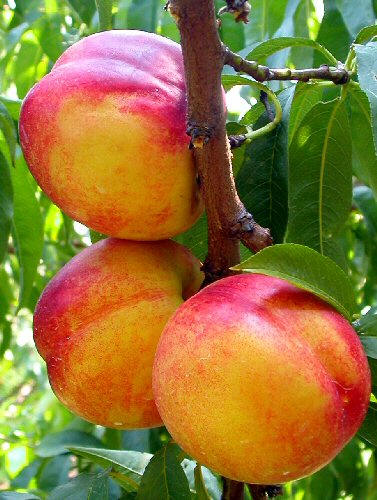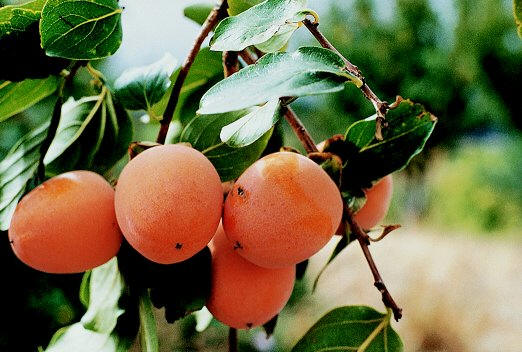



Captain Mark Yellow Nectarines Ripening on the Vine
It’s Summer 2005 -- Fruits -- Delicious, Nutritious, or Dangerous?
By "Swami" Mark Blackburn
July 2005
Summer 2005 Fruit Season in the Central Valley of CA
Friends if you live in Northern California you are at the zenith of the peach, nectarine, and apricot season. Also available are blueberries and blackberries, two foods considered presently to be extremely nutritious. If you are struggling through the hot weather and need cooling foods, watermelon, and cucumber are very cooling according to the TCM (Traditional Chinese Medicine) definition of heating or cooling foods. Eating lots of watermelon or cucumber is literally like drinking human-friendly coolant for your body. Also you’ll also find squashes and tomatoes (both are botanically fruits, not vegetables).
In another month we’ll be heavy into figs, and Crenshaw melons. Once the evenings cool again we’ll get the decorative fall squashes and the delicious casaba melons. As night temperatures approach freezing the noble Persimmon imported from China will emerge in profusion.
By mid-November the hideous gas-ripened, and nutritionally vacant navel oranges will appear at grocery stores everywhere. These are yellow on the inside instead of their obvious namesake ‘orange.’ By this time Captain Mark likes to join the mobile migratory birds and sail south for winter in warmer waters.
California an AG Powerhouse
This particular year has seen some of the strangest weather across California in decades. No doubt this has disrupted our vast farming industry. Are you aware that California grows 90% of the fruit grown in the USA? Are you aware that 6 of the 10 most agriculturally productive counties in the USA are in one valley in one state? (This is the San Joaquin Valley in California and #1 is Fresno County, #2 is Tulare County, and so on. (And, that is just counting California’s LEGAL crops)!
Friends, I have never in my life seen such filthy-garbage being fraudulently foisted upon a fickle fruit-loving public as in 2005. Let’s review the facts….almost all food sold in commercial stores is factory farmed, hybridized, genetically modified, or raised exclusively for the benefit of the merchandisers, and at the peril of the consumer (that’s you)! Every peach, nectarine, or apricot I have bought this year from supermarkets has been tasteless. If you get fruit that tastes bad, it IS bad. Don’t eat it. Return it for credit as deficient in nutrients.
Eat no fruit
Clearly one of the world’s greatest authorities on human health, Mr. Brian Clement, director of the Hippocrates Health Institute is intimately aware of the quality of commercial produce in the USA. He says it is best to simply avoid all fruit grown in the USA! Brian concludes that virtually all fruit sold domestically is garbage, and harmful to us. Can you imagine? Brian says that among all fruits commercially sold in the USA the least harmful may be Johnny Appleseed’s favorite.
Can fruit be safely eaten?
Well, is there ever a time when fruit could be consumed, and not at our peril? I believe yes, with moderation. But first, let’s describe what’s wrong with commercial fruit. It is routinely picked weeks prior to being ripe. Years ago grape farmers began “brixing” their grapes to determine when they were ready to pick. Using a refractometer, they measure a drop of grape juice for its sugar & mineral content. Interestingly the higher the sugars, the higher the nutritional value and mineralization of any plant. You can read more about brixing and plant nutrition here http://www.brixpage.com/.
Food merchandized by virtually all supermarkets and all chains, even those labeled “organic” foods are generally vacant of true nutrition as defined on the above cited brix website. Fruits in particular are abominable when picked before ripe, even if they are organic. The standard answer from your grocery clerk is, “put it in a paper bag and let it sit for a day or two, and it will ripen.” This is pure hogwash. The fruit should never be picked until it is ripe, and then it should expeditiously be eaten. This is how it happened for millennia back when humans were healthy and lived in a natural environment.
Ripe Fruit
There IS a time when fruit is ripe. There IS a time before it is ripe. There is a time AFTER the fruit is ripe. You should ONLY eat fruit when it IS ripe—not before, and not after. When fruit is ripe it falls off the tree. It is ideal to pick fruit that requires almost no tugging to get it to separate from its branch. If you have to yank, the fruit should be left for another few days. A typical tree will have ripening fruit for well over a month. Do not eat your fruit before it’s ripe, nor after. It is ideal to pick your own fruit off a tree. This is ideal. The worst possible choice is to buy fruit from a supermarket. Those are all junk plastic pretend fruit nutritionally vacant, picked way before ripe, and destined to rot not ripen.

Chocolate Persimmon
Farmer’s Markets
If you can’t do what’s ideal and pick the fruit directly off a tree, then be a discerning buyer at a farmer’s market. Most of this fruit is picked only a day or two before being ripe, and therefore has 10x the nutrition of store-bought fruit that is picked a week or more before ripe. When you select your fruit, try to get the fruit that is ripe right then. (And, eat it ASAP). Fruit that passes the point of ripe quickly ferments and this is a prime cause of Candida, now identified as a primary cause of cancer. If you select fruit that is not yet ripe, it will not have the nutrition of a ripe fruit. During the summer months there are farmer’s markets almost every day of the week. I recommend picking at least 2 per week in your area, and trying to shop them regularly. When I travel to other areas, I do a web search and locate the days, times, and locations of farmer’s markets, because I don’t want to become a victim of supermarket fake fruit. You will pay less at a farmer’s market, and you will get a far higher quality fruit or vegetable. You can meet the farmers directly and ask about their growing techniques. And, if you show up with a refractometer, they appreciate your measuring their produce for them. I have some raw food buddies in Seattle who never shop produce without their refractometer. Incidentally this instrument can measure the relative health of any plant using the juice from a leaf. I believe I paid around $60 for mine.
Miracle Seedless Fruits -- Avoid them!
Friends, I remember as a young man thinking seedless watermelon was worthy of the Nobel Prize. However, I urge you to go back and try a real watermelon. (Be careful…due to cross contamination/pollenization some watermelons sold as real are actually seedless). You want a nice red watermelon with nice big black seeds in it. I guarantee this kind of melon will taste far better than any seedless one. And, it’s nutritional value will be many times that of a seedless variety. Ironically, it is now very difficult to find a real watermelon at supermarkets. They cost more than the junk, tasteless, seedless varieties when you can find them. But, they really should. The real watermelon is a real fruit. (By definition fruits have seeds). Seedless grapes or melons are not a true fruit.....I don’t know what they are....'Franken-Food?'
Table Grapes – an electrical miracle
Grapes in the past 5 years have been lauded as one of the most magical and electric of foods. Today, virtually no supermarket will sell natural seeded grapes such as the incredibly delicious Concords, Ribiers, and Muscat grapes. You can ONLY find these at farmer’s markets. What is the healthiest part of the grape? The seed! I’m NOT kidding. If you eat seedless grapes you’re cheating yourself of 80% of its value. And, you’ll be eating a food of markedly inferior taste. When I began eating natural fruit (rather than hybrids) I found them to be electric with energy. I have a few places around Sacramento where I know I can go and pick grapes off a vine. These grapes are so profoundly delicious and electric they are instantly recognizable as being in a completely superior class. It is the same with virtually all fruit. Pick it off the tree or vine and you’ll think it’s a whole new fruit. I remember the first banana I ate when ripe right off a tree as a boy in Hawaii. It was an entirely different fruit to me than the hideous, pathetic excuse for a banana you are forced to buy at our local Safeway chain.
U-Pick Farms
I heartily recommend U-pick farms, and there are several in our region. I will try to post those here in the future.
Citrus Caution
Citrus fruits are very rough on the teeth. If you eat them, brush and rinse your teeth thoroughly as soon as possible. I do not recommend consuming more than a dozen per season. Most orange varieties are highly hybridized, and very much higher in acids than their original counterparts which are functionally extinct. (Hopefully they remain at some Geosperm Repository somewhere, such as the one in Riverside, CA). The least harmful citrus is probably the yellow Grapefruit.
Eating Seeds
Yes, Virginia, with regard to almost all fruit I recommend eating the seeds. (If not all of them, at least some of them). The human body, just like that of all the primates is perfectly adapted to do so. Examples include: Watermelon, Crenshaw melon, Papaya, Grapes. You don’t even have to think about eating the seeds of bananas, strawberries, blackberries, or kiwi. It's automatic. One huge exception is the Mango. Do NOT eat a mango seed, OK? Did you know that 1000 years ago a mango seed was worth its weight in gold? Every mango tree on the earth today was planted directly and actively by a human (rather than by a bird or other animal’s droppings). Ancient traders and travelers like Marco Polo would give mango seeds as a gift of great value.
Balancing Fruit with Greens
I agree with my Raw Food Associate Victoria Boutenko that we should be eating no more than 50% fruit--And, then, only if it is fruit we have picked when ripe and eaten immediately. I am trying to reduce down to 20% or less fruit, 80% greens.
Supermarkets
If at all possible, avoid them entirely. The best choices we have in Sacramento are the Sacramento Natural Foods Co-op and Whole Foods. After that, the “Major” with the best produce and most organic produce is Raley’s. After that it’s a crap-shoot & I won’t go there--(Safeway, Albertson, etc.). If you drive near Berkeley, I recommend the Berkeley Bowl, a fabulous Asian Store where you can buy on any given day probably 8 different varieties of mangoes, 10 different varieties of avocados, and they have an excellent organic section. Their prices are very reasonable. They have coconuts of far superior value to those available in Sacramento.
More General Fruit Information:
California Rare Fruit Grower's Association